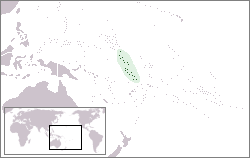Our website is made possible by displaying online advertisements to our visitors.
Please consider supporting us by disabling your ad blocker.
Gilbert and Ellice Islands
Gilbert and Ellice Islands Colony | |
|---|---|
| 1892–1976 | |
| Anthem: "God Save the King/Queen" | |
 | |
| Status | Protectorate of the United Kingdom (1892–1916) Colony of the United Kingdom (1916–1976) |
| Capital | Tarawa (1895–1908 & 1946–1976) Ocean Island (1908–1942) Funafuti (1942–1946) |
| Common languages | English (official) Gilbertese Ellicean Tokelauan |
| Demonym(s) | Gilbertese and Ellicean |
| Monarch | |
• 1892–1901 | Victoria (first) |
• 1952–1976 | Elizabeth II (last) |
| Governor | |
• 1892–1895 | Charles Richard Swayne (first) |
• 1973–1976 | John Hilary Smith (last) |
| History | |
• Protectorate | 1892 |
• Colony | 12 January 1916 |
• Separation | 1 January 1976 |
| Population | |
• 1892 | 26,430 |
• 1935 | 33,713 |
• 1936 | 34,433 |
• 1968 | 53,517 |
| Currency | Pound sterling (1892–1910) Australian pound (1910–66) Australian dollar (1966–76) |
| Today part of | Kiribati Tokelau (NZ) Tuvalu |
The Gilbert and Ellice Islands (GEIC as a colony) in the Pacific Ocean was part of the British Empire from 1892 to 1976. It was a protectorate from 1892 to 12 January 1916, and then a colony until 1 January 1976, and was administered as part of the British Western Pacific Territories (BWPT) until it became independent as two separate states. The history of GEIC was mainly characterized by phosphate mining on Ocean Island. In October 1975, these islands were divided by force of law into two separate colonies, and they became independent nations shortly thereafter: the Ellice Islands became Tuvalu in 1978, and the Gilbert Islands with Banaba (Ocean Island) became part of Kiribati in 1979.
Previous Page Next Page
Inizi Gilbert hag Ellice BR Illes Gilbert i Ellice Catalan Gilbert- und Elliceinseln German Insularoj Gilbert kaj Ellice EO Islas Gilbert y Ellice Spanish Gilbert eta Ellice uharteak EU جزایر گیلبرت و الیس FA Gilbert- ja Ellicesaaret Finnish Îles Gilbert et Ellice French Kepulauan Gilbert dan Ellice ID




